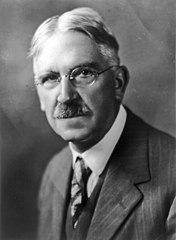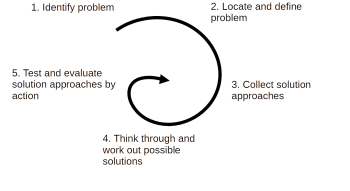Christian Stoll 2021
Basics of action orientation
In many schools, vocational schools, colleges, and universities, a common approach is to separate theory and practice on the same topic into different courses. The goal of action orientation (very much in the spirit of Pestalozzi) is to overcome this separation towards learning by doing (Herkner; Pahl, 2018, p.2).
Historical Background
One of the first significant concepts of action orientation comes from John Dewey (see Abbildung 1). In Dewey's publications, action is strongly linked to reflection and solving problems that fall out of the normal routine of action (Abels, 2011, p.49). He also speaks of Reflective Activity or Reflective Praxis (see Abbildung 2). First, one approaches the problem. The actual problem must be identified, then defined and embedded in a context. Based on this, hypotheses can be formulated and possible solutions can be collected. Then the further procedure can be planned and the solution approaches can be thought through and worked out. Now the solution approaches can be tried out and evaluated. This process is not finished, because there is never only one right solution and it is important to always be open for new/different possibilities and changes (Dewey, 1933, p.106-115).
According to Dewey Dewey (1933), competence development is made possible by the following circumstances:
- Confrontation with new problem
- Problem cannot be solved with previous action routines
- Problem is solved within the framework of a complete action
- Way of solution is reflected
Empirical studies from the 1980s show that a person's own actions lead him or her from a passive role as a listener to an active role as a participant. This in turn increases the motivation of the learners. In addition, content is consolidated much more strongly through this, especially when multiple senses are addressed (media and method diversity) (Herkner; Pahl, 2018, p.4).
Characteristics of action orientation
According to KMK (2018, p.32) , the objective of action orientation is „to enable people to plan, carry out and assess work tasks independently“.
 Abb. 3: Circle of complete action
Abb. 3: Circle of complete action
Basically, the learning and working process should be aligned with the cycle of a complete action: Inform, Plan, Decide, Execute, Control, Evaluate/Reflect (circle of complete action – see Abbildung 3) (Herkner; Pahl, 2018, p.4).
The KMK states the following orientation points for planning action-oriented lessons KMK (2018, p.17):
- Didactic reference points are situations that are significant for the everyday life and the future of the learners.
- Learning takes place in complete actions, preferably carried out by the learners themselves or at least mentally comprehended.
- Actions promote a holistic grasp of reality in an increasingly globalized and digitalized world of life and work (for example, economic, ecological, legal, technical, safety, vocational, technical and foreign language, social and ethical aspects).
- Actions pick up on learners' experiences and reflect on them in terms of their social impact.
- Actions also take into account social processes, for example the declaration of interests or conflict resolution, as well as different perspectives on career and life planning.
Products for action
The focus of the action orientation is on an action product. Activity products are products that are produced independently by the learners and have a subject/occupation reference or are characteristic for the respective subject/occupation. Products for action can be, for example.
- general workpieces,
- media products (audio, video, documents),
- also the planning of a workpiece/media product,
- the documentation of the creation of a workpiece/media product,
- a presentation (e.g. of a work result or a workpiece/media product),
- a portfolio or a learning diary.
In this context, action products can also be understood as a solution to a problem. The relevant question that I have to ask myself when planning a course is: What are typical subject/professional action products that can be created by learners within a course?
It is of course possible that an action product consists of many individual subproducts. The individual sub-products are then created in different courses, subjects or learning fields and are combined into an action product at the end of a certain period. It is also possible to have individual sub-groups create individual sub-products, which in the end result in an overall product.
At the end, it is advisable for the learners to present their products of action to each other, to give each other feedback and to first reflect orally on the creation process together.
Conclusion and grading
The documentation within a portfolio is suitable as a conclusion for the project. In this context, a portfolio consists of the following parts: the presentation of the activity product or the individual activity products, the documentation of the creation process and the reflection on the creation process. Since learners often do not have any experience with written reflections, it is useful to provide the learners with reflection questions. Within the portfolio, the feedback given and the results of the joint reflection can also be documented and included in the written reflection.
When grading and evaluating, it is advisable not to grade the activity product directly, but to grade the portfolio. This offers several advantages. First of all, the creation of a project documentation is a common task that can arise in everyday professional life (generally vis-à-vis the supervisor, in the free economy vis-à-vis customers or in the scientific field vis-à-vis third-party funding sources). Therefore it is obvious to get a certain routine here. In addition, the actual products of action, especially if it is possible to take different solutions, are very different depending on the previous knowledge and professional experience of the learners. If the portfolios are evaluated at this point, this again results in comparability in the evaluation. Depending on the learning group, there is also the possibility of bi-differentiated assessment.
In addition, a positive error culture can be conveyed. Even if the actual product of the activity does not meet the expectations at the end or does not meet all the requirements, this can be addressed and reflected on in the portfolio so that a good grade can still be awarded here.
Most important features of action orientation
- Action-based learning
- Experience-based learning
- Reflection on one's own actions and the experiences made

